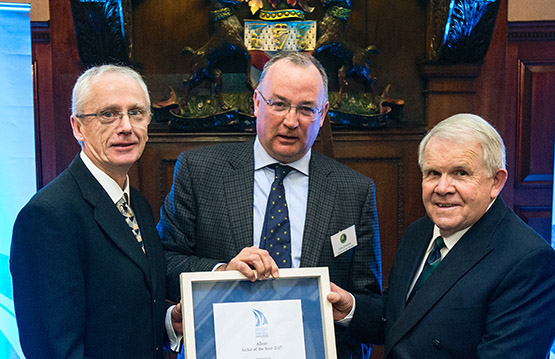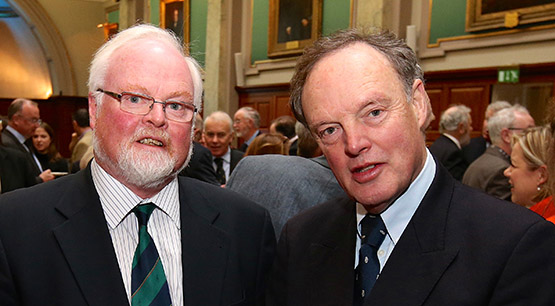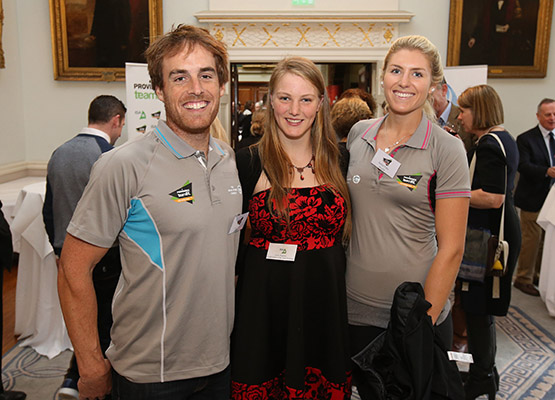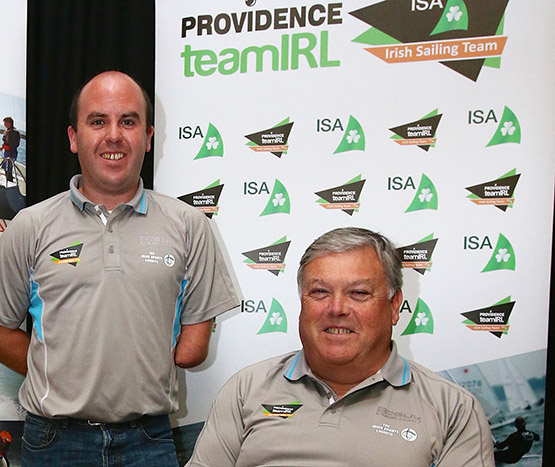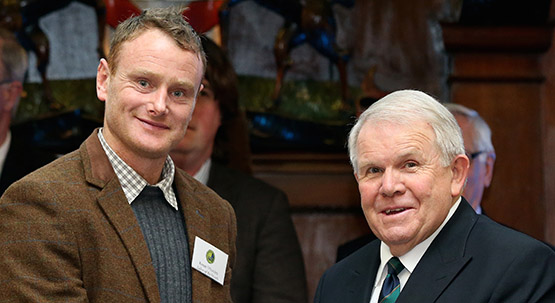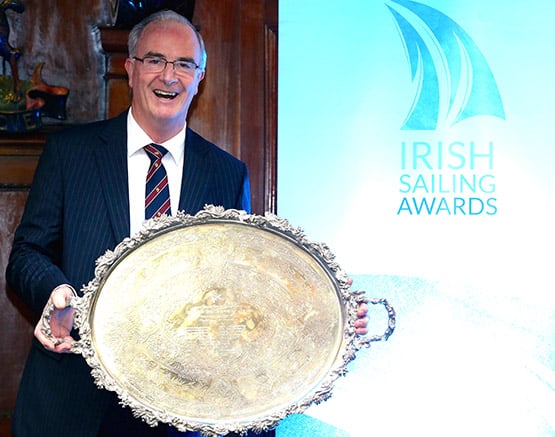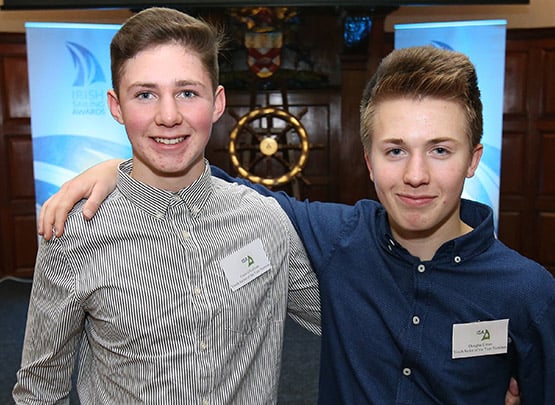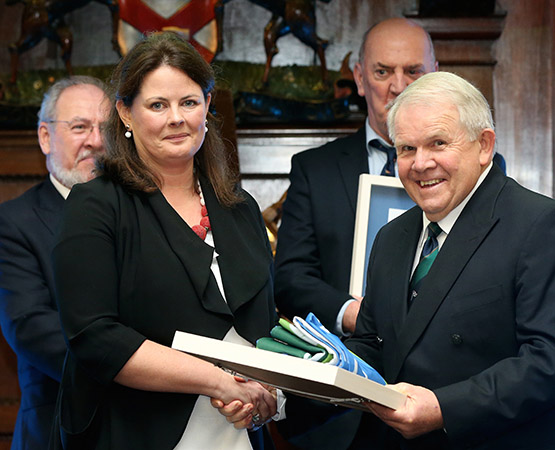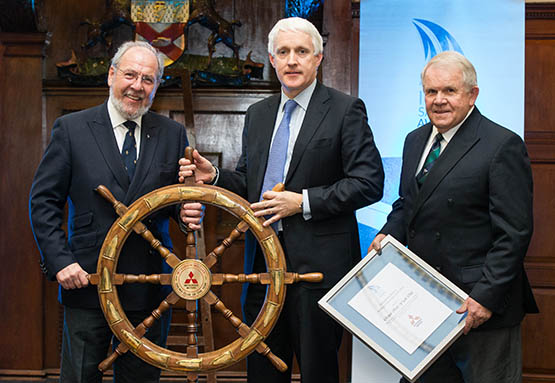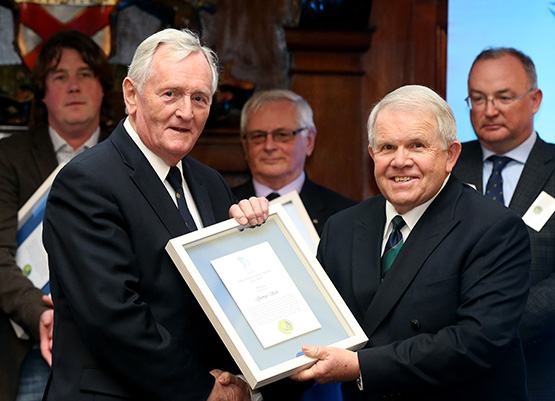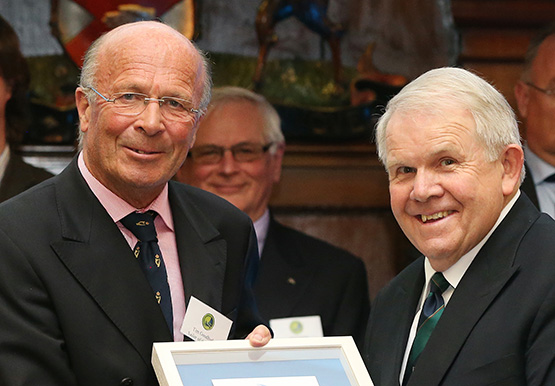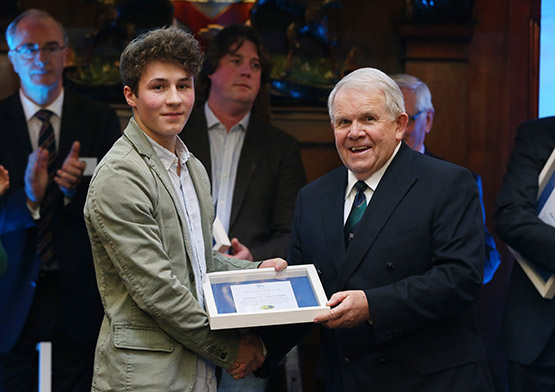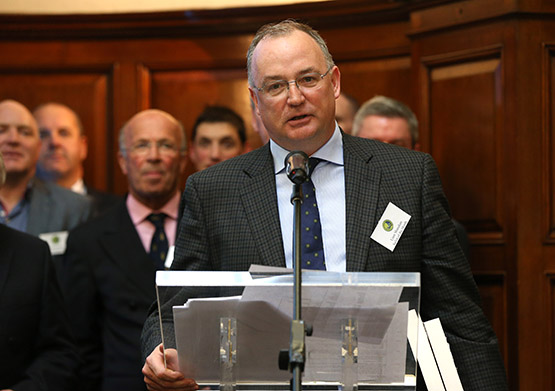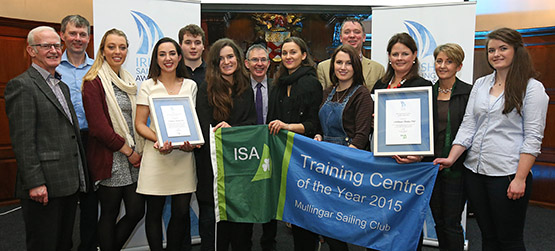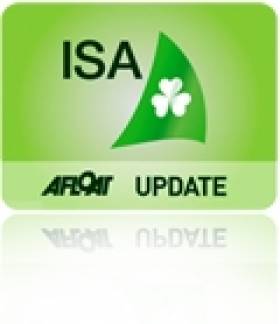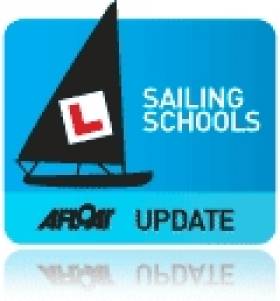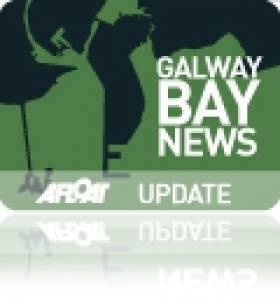Displaying items by tag: sailing
First Episode of The World Sailing Show
The first episode of The World Sailing Show, a brand new monthly view of the racing world is available above.
From non-stop around the world racers, to the intensity of Olympic campaigns, from seasoned professionals, to grass roots weekend warriors, The World Sailing Show will get into the latest action afloat.
In this first show we find out how the world's biggest trimaran, Spindrift 2, took three world records but narrowly missed out on the record they really wanted.
We also visit the Sailing World Cup in Melbourne to report on five sibling teams and catch up with the latest in the Paralympic classes.
We head to Malaysia to find out how Olympic aspirations are a family affair, while also taking a glimpse into the future from a different angle as we visit the Youth World Championships.
And we meet the new head of World Sailing, Andy Hunt, to find out what makes him tick.
Irish Sailing Celebrates the Best of the Best
The Irish Sailing Association Annual Awards ceremony undoubtedly conveyed three clearcut messages. The first is that, in global sailing terms, we’re a wet and breezy little island which nevertheless punches way above our weight. The second is that we live comfortably with a long and very distinguished history of recreational sailing which puts most other nations in the shade. And the third is that Ireland is definitely not the greatest place in the world to be a professional sailor. W M Nixon takes a look back at Thursday’s annual prizefest.
Those unfamiliar with the Royal College of Surgeons in Ireland might think it odd that, in just two short years, its splendid College Hall, at the very epicentre of Dublin on Stephens Green, has come to be seen as the most natural focal point for the annual honouring of our top sailors and clubs.
The College Hall in the RCSI provides an ideal setting for the annual gathering for Irish sailing’s national awards.
Sailors talking about sailing. The Awards Ceremony provides a cherished opportunity for sailors from every discipline to shoot the breeze together.
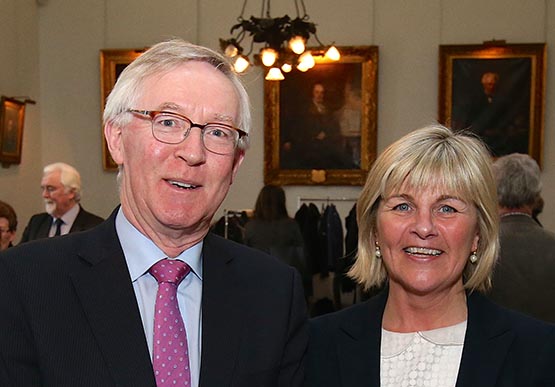
Dragons Den star Bobby Kerr – a sailing man himself – was the lively Master of Ceremonies
But in terms of being a setting which lends itself very positively to such a gathering, College Hall is right on target. It’s a splendid room which is confident with itself without being over the top. It comfortably accommodates the crowd of between 180 and 200 who have come from all over Ireland to celebrate what’s best in our sailing. And as if that weren’t enough, the RCSI has remarkable links with sailing going back more than a hundred years.
John Treacy, CEO of the Sports Council, with Liam Shanahan and ISA President David Lovegrove
So after last year’s first use of the venue, which stemmed from a typically far-sighted suggestion by ISA Board Member Brian Craig, people were keen to go back. And it wasn’t because no-one could think of anywhere better. On the contrary, it was because we’d found that the College of Surgeons is one of those wonderful buildings which make you feel better just from being in it. So in the early days of Spring when we wonder if summer is really going to come at all, a bit of a party in the College of Surgeons is just what the doctor ordered. And as for those doctors and surgeons from the RCSI going sailing, we’ll return to that at the end of this piece. But what of the event itself?
Well, with the Afloat.ie Sailor of the Year award going to a determinedly Corinthian skipper who cheerfully admitted that there’s any amount of professional sailors out there who could probably beat the pants off him, but nevertheless his core interest is offshore racing with family and friends, and if they win within those self-imposed limitations, then so much the better…..There it was, the real voice of Irish sailing, and no mistake.

Pierce Purcell of Galway Bay SC with the RIYC’s Michael Boyd, Commodore of the Royal Ocean Racing Club
But what about the clubs through which we go sailing? How can they carry such a wealth of history, and yet be of any contemporary relevance? Here again, the evidence speaks for itself. The new Mitsubishi Motors Sailing Club of the Year has a wonderful history going back to 1831, yet in terms of sailing achievement and voluntary input into the local, regional and national organisation of sailing, it is making a fantastic contribution. And as for its relevance to sailing in the future, independently of the Club of the Year adjudication taking place, this same club was comfortably on its way to being the top ISA Training Establishment in its region, and on the shortlist for the national title too.
Olympian and rising stars – James Espey, Aoife Hopkins and Saskia Tidey
If that’s not an illustration of the way that Irish sailing honours its past while living in the present and looking to the future, then I don’t know what it is. But what’s this third point about Ireland being a cold place for professional sailing? Here again, the assembly in the RCSI was very representative of our Irish sailing population. For sure, there are some very distinguished Irish professional sailors, and there are certainly Irish owners who are prepared to pay the top talents to sail with them. But there’s something about the Irish sailing scene which is inimical to such a setup at home. By all means do it where the weather’s usually benign, and there’s lots of money floating around. But in the Irish climate you sometimes have to be so keen to go sailing despite hostile weather that you just have to rely on nutty amateur crew - the professionals know there’s much better and more reliable pickings elsewhere.
Thus we’ve come to the ironic situation that our top home-based professional sailors are actually our Olympic hopefuls. It’s extraordinary when you think that the modern Olympics were “re-founded” in 1896 in order to celebrate amateur sport, yet now in Ireland just about the only home-based sailors who can be said to be professional are the Olympic aspirants. And if they haven’t accepted that they need a professional approach, then they’re not really at the races at all.
Thus although the friendly Olympian presence of Annalise Murphy, James Espey and Saskia Tidey was much to be welcomed in the very representative throng, generally anyone who was there with any sort of a professional interest in sailing had it as part of a larger business in which actually going sailing is only a small part of the total setup.
Paralympic sailors Ian Costello and John Twomey
Admittedly we did have one Olympian who received an award, John Twomey who took the title in December for his qualification for the Paralympics in September 2016. And he came with added laurels, as on the very day of the ceremony, it had been announced that he and his crew of Ian Costello and Austin O’Carroll had moved up to fifth in the World Rankings. But if you suggested to John Twomey – headed for his 11th Olympiad – that he’s a professional sailor, he’d be convulsed in mirth. Real life is related to an accountancy practice in Kinsale.
So the only other monthly awardee who could remotely be said to be a professional sailor was August winner Ronan O Siochru. who skippered the winning Irish Offshore Sailing boat Desert Star to victory in the 33-strong Sailing Schools Division in the Rolex Fastnet Race 2015. But he’s very definitely running a business - and a very demanding one at that – in which going sailing is only part of it.
Ronan O Siochru with the President
Thus what Thursday’s ceremony was all about was voluntarism and amateur sport, and in case anybody missed the point, it was supposed to be a bit of fun. In this spirit, the greatest trophy in Irish sailing, the might salver for the Helmsman’s Championship, was given an outing. The All Ireland Helmsman’s Championship being an amateurs-only affair, as it is held over an October weekend, inevitably by the time its award ceremony for the salver is shaping up it’s well into Sunday evening. It’s getting dark, and everyone’s tired and wants to go home. So inevitably the handing-over of the historic trophy is a downbeat and somewhat rushed affair.
But as the ISA Annual Awards ceremony is all about handing over prizes with as much ceremony as possible, it was arranged for the salver – which had been hurriedly handed over to successful defender Anthony O’Leary in Dun Laoghaire back in October – to be smuggled out of the O’Leary household down in Crosshaven, secretly taken to Dublin, hidden away in the College of Surgeons, and then formally presented as a surprise extra to the great man after he’d received his Sailor of the Month award for April. He blushed.
Got him! Sailor of the Year 2014 Anthony O’Leary unavoidably missed last year’s awards ceremony, and then in 2015, although though he was Sailor of the Month for April, there were very few people around in October when he successfully defended the Helmsmans Championship Salver. So it was taken secretly to this week’s ceremony, where more than 180 people cheered him to the rafters.
ISA Youth Champions 2015 are Colin O’Sullivan and Doug Elmes, Bronze Medallists in the 420 Worlds.
Before all this, we’d been setting the scene with the ISA Youth Sailors of the Year, who were 420 Worlds Bronze Medallists Douglas Elmes and Colin O’Sullivan, and the ISA Training Centre of the Year, which was Mullingar Sailing Club from Westmeath which headed the Western Region, and overall came in ahead of Foynes YC from the Southern Region and the Royal Irish YC from the Eastern Region.
Katie Johnston of Mullingar Sailing Club with David Lovegrove when MSC was announced as ISA Training Centre 2015.
The new Mitsubishi Motors Sailing Club of the Year is the Royal Irish YC – Commodore James Horan with Billy Riordan of Mitsubishi Motors and David Lovegrove.
But for the RIYC Commodore James Horan, the good news was only beginning, as his club was then announced as the new Mitsubishi Motors Sailing Club of the Year for a host of excellent reasons. We’ll list them in more detail here on Afloat.ie in due course when the traditional handing-over ceremony for the old ship’s wheel trophy is held in the RIYC clubhouse later in the Spring. But meanwhile on Thursday we saw ample reason for it, as two of the Sailor of the Month awards went to very active RIYC members, George Sisk and Tim Goodbody.
July Sailor of the Month George Sisk with the ISA President
Dun Laoghaire Regatta Week 2015 Chairman, Fastnet Race 1987 overall winner, and multiple champion Tim Goodbody was Sailor of the Month in November
Youngest cruising award winner was Fergus Ogden, who in June and July sailed round Ireland with his brother in an open Drascombe Lugger.
Then came the Sailor of the Year announcement. Anyone who was following the voting in the Afloat.ie poll will know it was running very close. But as the poll results are only a quarter of the adjudication process, it was just a couple of days ahead of the awards ceremony when the judges finally made their decision. They came down in favour of Liam Shanahan both for his wonderful and very sporting victory in the Dun Laoghaire to Dingle Race with his family’s J/109 Ruth, and his subsequent success in retaining the Irish Sea Annual Championship title.
His modest acceptance speech was, in effect, a manifesto on behalf of all Irish amateur sailors, and particularly family sailors. The Shanahans are one remarkable sailing tribe right through three generations. And as for that win in the Dun Laoghaire to Dingle Race – well, it was beautiful sailing. Some sailing races are won by brutal slugging. Some are won by sheer cunning. Some inshore races are even won by dirty sailing, and it’s within the rules even if it does the image of our sport no good at all. But some race wins are simply beautiful sailing. And Ruth’s success in Dingle was definitely in that category.
After receiving his award, Liam Shanahan briefly but eloquently outlines his philosophy of sailing
So the ceremony on Thursday concluded with this celebration of the best in Irish sailing, and it chimed well with the mood of the moment and the location, as the current President of the RCSI is Declan Magee who sails from Dun Laoghaire, and he was most welcome at the party and naturally thanked for the use of the hall……
Then as we exited the College Hall, the first doorway we passed was the Sir Thomas Myles Room. He was RCSI President 1900-1902, a wonderful surgeon and a man of prodigious energy who boxed to championship level, and adored sailing. A Home Ruler of Limerick origins. he made his auxiliary ketch Chotah available to take the guns off Conor O’Brien’s Kelpie during the Asgard gun-running of 1914, and landed them in Kilcoole in County Wicklow. And though he was immediately made a Colonel and head of British army surgical services in Ireland on the outbreak of the Great War of 1914-18, he also saw to it that hidden rooms in the major Dublin hospitals under his control were available to treat wounded rebels, indeed anyone who was wounded, during the Rising of 1916.
Builders of the future – the team from Mullingar Sailing Club, ISA Training centre 2015
More recently, a leading sailing figure with links to sailing is Michael O’Rahilly who, when he became a student at RCSI at the end of the 2950s, found that the RCSI Sailing Club consisted of just one neglected Firefly dinghy. By the time he graduated in 1963, he was Club Captain, RCSISC had three Fireflies in top racing condition, and they were the Irish university champions.
Subsequently he went in to play a leading role in Dublin Bay SC, and was the Commodore for the DBSC Centenary in 1984. He follows in a notable RCSI tradition of sailing and working voluntarily for our sport, as an earlier top sailor in the college had been Jimmy Mooney who played a key role in the development of Irish dinghy sailing, and then went on to be our top Dragon sailor for many years, winning the Edinburgh Cup and representing Ireland in the Olympics.
Before Jimmy Mooney another noted character in the RCSI sailing scene was Rory O’Hanlon, who became a noted figure in offshore racing – he won a cup in the 1971 Fastnet Race – and was further renowned for his long distance cruising exploits.
He was noted as a kindly mentor to young cruising hopefuls, gently giving encouragement which could make all the difference to a nervous skipper. One such beginner, who later went on to great achievements, nervously went to Rory O’Hanlon to ask how best he should approach his first major voyage, north towards the Arctic in a little 26-footer.
“Sure, you just keep on sailing, and you’ll get there” said Rory. “Just keep on sailing, that’s all there is to it”. Just keep on sailing. It’s sensible advice. It resonated round College Hall in the RCSI on Thursday afternoon. We should all heed it.
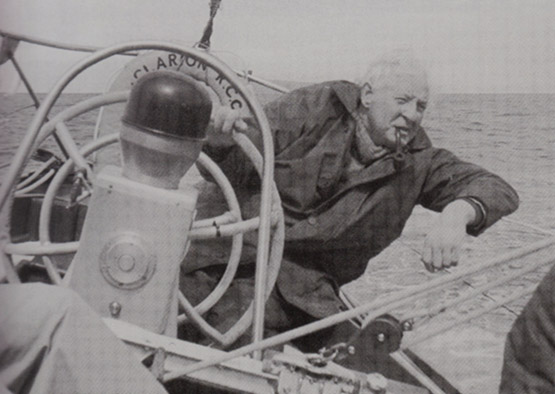
“Just keep on sailing, and you’ll get there”. The late Rory O’Hanlon at the helm of his S & S 43 Clarion with which he won the Philip Whitehead Cup in the 1971 Fastnet Race, and also cruised on long voyages. While a student at the Royal College of Surgeons in Ireland, he was active in the sailing club.
See also: Sailing Awards slideshow
Irish Sailing Association 2016 Calendar of Fixtures
| Start | End | Name | Boat Class | Venue |
|---|---|---|---|---|
| 06/02/16 | 07/02/16 | IUSA Westerns | Fireflies | Killaloe SC |
| 25/02/16 | 28/02/16 | IUSA Varsities | Fireflies | Kenmare |
| 26/03/16 | 27/03/16 | Munster Championships | Laser | Baltimore Sailing Club |
| 10/04/16 | 10/04/16 | Traveller 1 | Topper | East Down YC |
| 23/04/16 | 24/04/16 | Mirror Westerns | Mirror | Sligo YC |
| 23/04/16 | 24/04/16 | Ulster Championships | Laser | Coounty Antrim Yacht Club |
| 23/04/16 | 24/04/16 | RS400 Easterns | RS | Royal St George YC |
| 23/04/16 | 24/04/16 | RS200 Easterns | RS | Royal St George YC |
| 24/04/16 | 24/04/16 | Traveller 2 | Topper | Lough Derg YC |
| 08/05/16 | 08/05/16 | Traveller 3 | Topper | Wexford Harbour B&TC |
| 14/05/16 | 16/05/16 | Leinster Optimist Championships | Optimist | Royal St George YC |
| 14/05/16 | 15/05/16 | Optimist Leinsters | Optimist | Royal St George YC |
| 21/05/16 | 22/05/16 | Ulster Championships | Topper | Donaghadee SC |
| 21/05/16 | 22/05/16 | GP14 OT & Purcell | GP14 | Swords Sailing & BC |
| 21/05/16 | 22/05/16 | J/24 Northerrns | J/24 | Sligo YC |
| 21/05/16 | 22/05/16 | RS400 Northerns | RS | Cushendall Sailing & Boating Club |
| 27/05/16 | 29/05/16 | Sportsboat Cup 2016 | Various | Howth YC |
| 27/05/16 | 29/05/16 | Dragon East Coast Championship | Dragon | Royal Irish YC |
| 28/05/16 | 29/05/16 | Squib Northern Championship | Squib | Killyleagh SC |
| 04/06/16 | 04/06/16 | Lambay Races 2016 | All Classes | Howth YC |
| 10/06/16 | 12/06/16 | ICRA National Championships 2016 | Cruisers | Howth YC |
| 10/06/16 | 12/06/16 | Wayfarer National Championship | Wayfarer | Ramor Watersports Club |
| 11/06/16 | 12/06/16 | Optimist Connaughts | Optimist | Foynes YC |
| 18/06/16 | Volvo Round Ireland Yacht Race | Cruisers | Wicklow SC | |
| 18/06/16 | 18/06/16 | Royal Alfred Bloomsday Regatta | All Classes | National YC |
| 18/06/16 | 19/06/16 | Leinster Championships | Topper | Skerries SC |
| 25/06/16 | 26/06/16 | GP14 Ulsters | GP14 | East Down YC |
| 25/06/16 | 26/06/16 | RS400 Westerns | RS | Sligo YC |
| 25/06/16 | 26/06/16 | RS200 Westerns | RS | Sligo YC |
| 01/07/16 | 01/07/16 | Optimist VP Team Racing Cup | Optimist | Malahide YC |
| 01/07/16 | 03/07/16 | White Sails and Non Spinnaker Team Challenge | Cruisers | Royal St George YC |
| 01/07/16 | 03/07/16 | Dingy West 2016 - Sailing the Wild Atlantic | All Dinghies | Galway Bay Sailing Club |
| 02/07/16 | 03/07/16 | Connaught Championships | Laser | Lough Derg YC |
| 02/07/16 | 03/07/16 | Optimist Ulsters | Optimist | Malahide YC |
| 02/07/16 | 03/07/16 | J/24 Southerns | J/24 | Royal Cork YC |
| 02/07/16 | 03/07/16 | Fireball Leinsters | Fireball | Wexford Harbour B&TC |
| 02/07/16 | 04/07/16 | Irish Nationals | Topper | Royal Cork YC |
| 10/07/16 | 15/07/16 | Volvo Cork Week & IRC European Championships | Various | Royal Cork YC |
| 15/07/16 | 17/07/16 | Ruffian 23 National Championship | Ruffian 23 | Dun Laoghaire MYC |
| 16/07/16 | 17/07/16 | Optimist Crosbie Cup | Optimist | Lough Ree YC |
| 16/07/16 | 17/07/16 | Leinster Championships | Laser | National YC |
| 17/07/16 | 17/07/16 | Traveller 4 | Topper | Carrickfergus SC |
| 22/07/16 | 24/07/16 | Mirror National Championships | Mirror | Sutton Dinghy Club |
| 23/07/16 | 30/07/16 | Laser Radial World Championships (Men's & Youth's) | Laser | Royal St George YC |
| 23/07/16 | 24/07/16 | GP14 Leinsters | GP14 | Sutton Dinghy Club |
| 23/07/16 | 24/07/16 | RS400 Southerns | RS | Lough Ree YC |
| 23/07/16 | 24/07/16 | RS200 Southerns | RS | Lough Ree YC |
| 23/07/16 | 29/07/16 | World Championships | Topper | Ballyholme YC |
| 27/07/16 | 30/07/16 | WIORA 2016 | Cruisers | Royal Western YC |
| 30/07/16 | 01/08/16 | Arklow Maritime Festival | All Classes | Arklow SC |
| 06/08/16 | 07/08/16 | J/24 Westerns | J/24 | Lough Ree YC |
| 07/08/16 | 07/08/16 | Sutton Dinghy Regatta | All Classes | Sutton Dinghy Club |
| 07/08/16 | 12/08/16 | Mirror Europeans 2016 | Mirror | Royal Cork YC |
| 09/08/16 | 11/08/16 | 420 Nationals | 420 | Howth YC |
| 12/08/16 | 13/08/16 | Sailability President's Cup | Various | Kinsale YC |
| 12/08/16 | 14/08/16 | Fireball Nationals | Fireball | Howth YC |
| 15/08/16 | 19/08/16 | Optimist Irish Nationals | Optimist | Lough Derg YC |
| 19/08/16 | 21/08/16 | Squib Irish National Championship | Squib | Kinsale YC |
| 20/08/16 | 23/08/16 | National Championships | Laser | Galway Bay Sailing Club |
| 26/08/16 | 28/08/16 | RS400 Irish Nationals | RS | Schull Harbour SC |
| 26/08/16 | 28/08/16 | RS400 Irish Nationals | RS | Schull Harbour SC |
| 27/08/16 | 29/08/16 | GP14 Irish & Masters | GP14 | Skerries SC |
| 27/08/16 | 28/08/16 | Munster Championships | Topper | Kinsale YC |
| 27/08/16 | 28/08/16 | Mirror Northerns | Mirror | Royal North Of Ireland YC |
| 27/08/16 | 28/08/16 | Topper Munster Championship | Topper | Kinsale YC |
| 28/08/16 | 28/08/16 | Taste of Greystones Cruiser Regatta | Cruisers | Greystones SC |
| 31/08/16 | 04/09/16 | Dragon Irish Championship | Dragon | Kinsale YC |
| 02/09/16 | 04/09/16 | J/24 Nationals | J/24 | Royal St George YC |
| 03/09/16 | 04/09/16 | Wayfarer Inland Championship | Wayfarer | Callaun SC |
| 10/09/16 | 11/09/16 | Optimist Munsters | Optimist | Royal Cork YC |
| 10/09/16 | 11/09/16 | Fireball Munsters | Fireball | Killaloe SC |
| 11/09/16 | 11/09/16 | Traveller 5 | Topper | Killyleagh SC |
| 17/09/16 | 18/09/16 | All Ireland Inter-Schools Championship | All Classes | Sutton Dinghy Club |
| 24/09/16 | 25/09/16 | GP14 Autumn & Youth | GP14 | Sligo YC |
| 24/09/16 | 25/09/16 | ISA All Ireland Youth Championships | TBC | TBC |
| 01/10/16 | 02/10/16 | ISA All Ireland Senior Championships | J80 | TBC |
| 15/10/16 | 16/10/16 | Squib Inland Championship/Freshwater Regatta | Squib | Lough Derg YC |
Rio 2016 Olympic Sailing Regatta Schedule Published
A provisional racing schedule for the Rio 2016 Olympic Sailing Competition set to be held in Rio de Janeiro, Brazil from 5-21 August 2016 has been released. Download the race schedule below. Three Irish boats have qualifed for Rio and a fourth may qualify next month. An Irish Race Officer will also officiate at the regatta.
The Pão de Açucar, Ponte and Escola Naval courses inside Guanabara Bay and the Copacabana and Niteroi areas outside the bay are to be utilised. The reserve course areas are Aeroporto, an additional course situated in-between Ponte and Escola Naval in Guanabara Bay, and Pai, outside Guanabara Bay.
Racing is set to start on Monday 8 August at 13:00 local time with the Men's and Women's RS:X sailing on the Pão de Açucar race track. The Laser and Laser Radial fleets will also commence their competition on Escola Naval course on the same day.
The Finn sailors will start racing on Tuesday 9 August on the Pão de Açucar area with the Men's and Women's 470 as well as the Nacra 17 following on Wednesday 10 August. The 49er and 49erFX are the last fleets to start and get going on Friday 12 August.
The first Medal Races will take place on Sunday 14 August with two per day scheduled until Thursday 18 August where the 49er and 49erFX will bring the regatta to a close.
With the schedule shared with the sailors, the announcement has been met with anticipation, and the feedback given with an emphasis on the diversity and beauty of the courses at the forefront of their minds.
Men's 470 London 2012 gold medallist, Australia's Mat Belcher said, "It's much anticipated as the teams want to know what they can expect at the Games and there has been a lot of speculation where different classes are going to race. I guess we are all really excited now it has come out.
"The unique thing about Rio, and the great thing about Rio, is the diversity of the conditions and also the diversity of the different race areas, and that makes for the best all-round sailor.”
On the mixture of racing areas, five-time Olympic medallist, and Brazil's very own Robert Scheidt agreed, "We are going to have many courses which we are going to sail in. I think this is good because it really tests the ability of the sailors in different conditions. It is a place where the sailor has to be very flexible and adapt himself.”
Heading into her third Olympics, Belgium's Evi Van Acker is also excited about what is on the horizon, "It's a nice mix of everything, sailing inside and outside, and I think it's the most fair for everyone to do a bit of everything. I love the venue. Every course is different so it's good that we sail on them all.”
With the sailors agreeing that Rio 2016 offers a fantastic mix to test the sailors, they also agree that the Rio Games will put sailing into the spotlight by featuring the Medal Races close to the iconic beaches.
"As a Brazilian, it would be amazing to sail in the Medal Race because we know it will be a big crowd out there," said an expectact Scheidt. "The Brazilian flags will be flying and there will be support from thousands of people watching the race.”
Belcher said, "What's great about Rio is the anticipation of racing closer to shore. It's very difficult for the sailors, but for our sport we need to generate more interest from the public and what better way to do it than seeing so many spectators lining Flamengo Beach to watch us race.”
Echoing the thoughts, Van Acker added, "I expect everyone to be on the beach. It's great as the spectators don't get much chance to see us racing and it will be beautiful in Rio for them to watch.”
The release of the schedule not only gave the three sailors a better picture of what they can expect next year, but it also stirred up some emotions from Scheidt as he reflected on his Olympic Laser career possibly coming to an end in his homeland.
Looking at the schedule, Scheidt concluded, "For myself, I'm only doing this Olympic cycle because the Olympics is in my home country. That's a big thing and I want to feel that emotion. It's going to be something that will stick with me for a long time.
"Will it be my last one? You can never say never you know, but probably yes. I'm already, let's say, an advanced age for the laser, but my body is still holding up well and I think I can be very competitive in Rio, but after that I probably won't continue in the lasers, but let's see the opportunities after the Games.”
#sailing – Irish Sailing Association (ISA) President David Lovegrove on the summer ahead
The sun is finally showing its face on Irish waters, and just in time as the summer sailing season is now in full swing, with boats taking to the water in higher numbers than previous years. I am in regular contact with Clubs across the country and they speak of the positive mood coursing its way through their sailing communities.
Much of this of course has to do with the resurgence of the Irish economy following years of austerity, cutbacks, and a drop in sailing participation. The marine industry now reports that sales of boats coming into the country are on the up; handicap applications are increasing following a lull in requests, and this can only mean one thing – more boats on the water. The Irish Cruiser Racing Association (ICRA) Nationals, Sovereigns Week and Dun Laoghaire Week are all benefitting, with buoyant numbers reported as boats come out to compete in what should be a bumper summer season.
This summer will also see DinghyFest hit the shores of Crosshaven, Royal Cork Yacht Club (RCYC) creating a new event - could this herald the resurgence of Dinghy Week? I note the cooperation between the ISA and the dinghy classes, which I hope will lead to an upsurge in the numbers of dinghy sailors, which fits with our policy of growing this area within Irish sailing.
In other positive news, it was great to hear that the ISA has won the National Inclusion Award under the category of National Governing Body of Sport for the commitment and focus displayed in respect to providing sport and physical activity opportunities for people with disabilities.
I am also pleased to announce that SafeTrx, the ISA app that monitors your boat journeys and alerts Emergency Contacts should you fail to return on time, has been shortlisted for the Maritime Industry Awards in the categories of Innovation in Maritime Safety and Innovation in Marine Technology.
On 18 June, the Minister for Agriculture, Food and the Marine, Simon Coveney launched Try Sailing on board the Jeanie Johnston in Dublin. Try Sailing is a national initiative, designed to drive participation in sailing locally through open days and events at centres and clubs across the country. For more information, visit www.trysailing.ie
Spring saw the ISA AGM adopt the Strategic Plan 2015-2020 – the blueprint for the future of sailing in Ireland. This plan is now being implemented across the key areas within sailing. The AGM elected two new officers to the Board, and said goodbye to Mike O'Connor and Phillip Cowman, who both retired after seven years on the ISA Board. I would like to thank them for their service and welcome to the Board Robert Dix, former ISA President and Chairman of the Government Taskforce on Harnessing our Ocean Wealth; and Paddy McGlade, ex-RCYC Admiral and member of the Irish Cruising Club and Cruising Association of Ireland.
On the Performance side of the house, Providence Team IRL has been competing on a number of fronts, notably at the World Cup series and significant international-class regattas, such as the Delta Lloyd, where Annalise Murphy in the Laser Radial claimed a Silver medal in trying conditions amidst a fleet of top sailors, including Olympic Silver and Bronze medallists. I was also delighted to see 16–year–old Aoife Hopkins from my own Howth Yacht Club secure an invite to the World Cup Series event at Weymouth in the Laser Radial class. Aoife has put in a series of impressive performances this year, including a big week at the Delta Lloyd Regatta in late May.
On the Paralympics front, the ISA is working with the International Sailing Federation (ISAF) to lobby the International Olympic Committee to reinstate Paralympic sailing at the Tokyo 2020 Paralympics.
Enjoy your summer sailing.
David Lovegrove
President, Irish Sailing Association.
Try Sailing, Kayaking & Paddleboarding For A Tenner
#trysailing – Alistair Rumball's Irish National Sailing School is holding its first Open Day this month at its base on Dun Laoghaire's West Pier with the aim of introducing newcomers to the sport. The Irish National Sailing and Powerboat School and the newly formed Irish National Sailing Club, will be opening its centre to the public on June 21st and you can try out Sailing, Kayaking, Paddle-boarding or Powerboating for just €10.
'We want everyone to be able to share in a sport that we love, sailing after all is a skill for life' Rumball told Afloat.ie.
Rumball, who featured recently in WM Nixon's Sailing on Saturday Blog, says he spent the winter 'investing in our fleet of boats and revamping our teaching syllabus, so much so that we are planning to put it all on display'.
The initative is part of the National Water Safety Awareness Week 2015 from Irish Water Safety, and in association with The Irish Sailing Association's Try Sailing initiative. Galway Bay Sailing Club held the West of Ireland's first " Try Sailing " launching in May, with up to 400 people getting on the water.
The Irish National Sailing Club will be on hand with its members and instructors to get as many people as possible on the water so they can experience a number of different water sports.
More information on the poster downloadable below or by emailing [email protected] or phoning 01 2844195.
Galway's Successful Launch of 'Try Sailing'
#trysailing – Galway Bay Sailing Club held the West of Ireland's first " Try Sailing " launching over the weekend, with up to 400 people getting on the water yesterday for the ISA's new initiative, which is part of an Access and Participation programme linked with Irish Water Safety to promote water safety and sailing.
Developed from a suggestion from Muriel Rumball of the Irish National Sailing School in Dun Laoghaire, the linkup with IWS allows promotion of the programme in schools, and the numbers involved showed the success of this approach.
Around 175 were complete beginners who had never before been on the water in Galway. And it was like the previous night 's Eurovision, with eleven different nationalities represented - our "new Irish" citizens are keen to get afloat.
The Day was co-ordinated by GBSC Public Relations Officer Phyllis Hayes, who organised up to 60 boats and nearly 220 members including juniors, parents, instructors and officers. Irish TV.ie covered the day's events, which will be broadcast on 15th June , which is the first day the first day of IWS Water Safety Week. And there will be another Try Sailing initiative to round out the week on June 21st, Midsummer's Day.
#Rio2016 - Brazil has hurried to squash growing fears over the safety of sailing waters for next summer's Rio Olympics – but one state official's dip in Guanabara Bay hasn't stemmed the backlash.
The Associated Press reports on the "televised stunt" last week that saw environmental secretary Andrea Correa dive into the waters where sailors are expected to race just over a year from now.
In the footage recorded for the news magazine show Fantastico – which previously aired a report highly critical of Rio's failure to fulfil its promises to clean up the notoriously polluted Guanabara Bay – Correa compared its waters to the popular beaches of "Ipanema or Barra".
But the PR exercise did not impress the Fantastico team, who stressed in their programme that the official selected the time and place for his dip, at high tide near the mouth of the bay in cleaner ocean water.
Commenting on the story at the Royal Cork YC website, Peter Webster – a chemist with the Environmental Protection Agency (EPA) – repeated concerns that Rio's sailing waters fall far short of European bathing water quality standards.
"For our Olympic competitors... these standards should be being demanded by the ISA or the relevant swimming national bodies," he says. "From the evidence I’ve seen of pollution in Guanabara Bay there is no way that water-sports of any kind should be being held there."
The ISAF has already suggested it could make a formal call to move Olympic sailing out of the city for the safety of athletes.
#Rio2016 - Annalise Murphy, James Espey, Ryan Seaton and Matt McGovern are already Rio-bound - but could their sailing venue at the 2016 Olympics be moved out of Guanabara Bay?
That's what the sport's world governing body has threatened to do if city authorities don't clean up their act, according to the Associated Press.
As previously reported on Afloat.ie, local Olympic officials have confirmed that the notoriously polluted waters of Brazil's largest city will not be fully cleaned as promised in time for next summer's Olympiad.
The sailing venue was slammed as "absolutely disgusting" by Irish Olympic sailing coach Ian Barker on a visit to Rio at the end of 2013.
Yet while hopes remained in the interim that city officials would make good on their assurances of safe and clean waters for sailors, those have been dashed in recent weeks – with safety concerns over floating rubbish and the discovery of a new 'super-bacteria' in one of the many sewage-filled rivers that flow into the bay.
That's not to mention similar worries over the venue for rowing and canoeing at the Rodrigo de Freitas Lagoon – recently the site of an extensive fish kill.
The situation has now prompted the ISAF to call on the International Olympic Committee (IOC) to step up the pressure on Brazil's politicians, with the sailing body's Alastair Fox claiming he and fellow officials were "frustrated with it all".
In a phone interview with the AP's Stephen Wade, Fox said: "We are going to review the situation and make some more recommendations – demands is probably the right word – to make sure things are done."
The ISAF's head of competitions also suggested that "if we have to race all the races outside the bay, if that's what it comes to, to ensure a fair regatta, then that's something we're going to explore and could do."
The AP has much more on the story HERE.
Ireland's Invisible Boat Builders
#boatbuilders – In the good old days of bespoke boat-building, regular visits to the boatyard by the prospective owners were a sociable part of the process, regarded as normal and mutually instructive. And as most boats were built in waterfront premises beside slipways, or at the very least on a quayside, the first immersion was much more than just an informal splash from a convenient travel-hoist or a crane. On the contrary, it was the Launching Ceremony, a carefully choreographed festive event complete with the breaking of a bottle and sometimes even including the proper blessing of the new boat.
But nowadays, while such events can to some extent be staged, inevitably they have a certain artificiality. With transportation vehicles and roads improved out of all recognition, most production boats are now being built in factories at some distance from the sea - waterfront property is much too valuable to be used for basic industrial purposes.
As for seeing "your" boat being factory-built, you have to be up towards the top of the product range to be allowed that, and even then you mustn't bother the builders by talking to them. So the "launching" is simply a practical task carried out by professional marina staff with a minimum of fuss, for it has always been the case that when you just want to get on with a launching in a businesslike way, the last person you need around the place is the fretful owner.
Thus today's marine industry aspires to be the waterfront version of the car trade. Smooth, clean and impressive premises. Ready-to-go immaculate vehicles. And no hint at all of the need to get deep down and dirty in the building and maintenance of boats. But not every sailing and boat enthusiast is content with accepting such production-line techniques. W M Nixon takes a look at some of Ireland's invisible boat builders who cater for those owners who are different, and sometimes are doing it entirely for themselves. He also reveals the revolutionary Clontarf Contrivance, a Boon for Boatbuilders in classic style.
There are two Gods in the pantheon of Ireland's invisible boat-builders. One is Jimmy Furey, who creates exquisite classic clinker-built beauties to order in his tiny workshop in County Roscommon near the west shore of Lough Ree. And the other is Roy Dickson, who is incapable of sailing any boat without thinking of some way he'd like to improve it, and was a pioneer of the DIY dinghy-building movement in Ireland a very long time ago.
They're the Gods of our pantheon as both are now well into their eighties, and their influence has spread far beyond the shores of Ireland despite the fact that both are unassuming men who like nothing better than quietly getting on with the job.
But while Jimmy Furey is part of a long and distinguished Shannon tradition in that his innate talents emerged from working with his boat-builder brother Paddy, and are in turn being passed on to other master craftsmen such as Dougal MacMahon of Belmont on the western stretches of the Grand Canal, Roy Dickson is a complete one-off who is an inspiration to many, but you couldn't really say that there is a Roy Dickson School of Boat Re-Configuration.
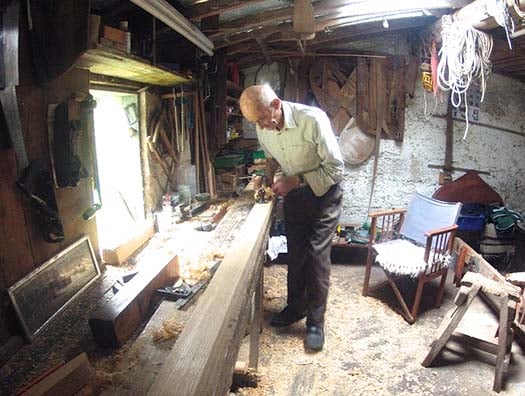
Jimmy Furey quietly in action in his remote workshop in County Roscommon on the west shore of Lough Ree. Photo: Cathy McAleavey
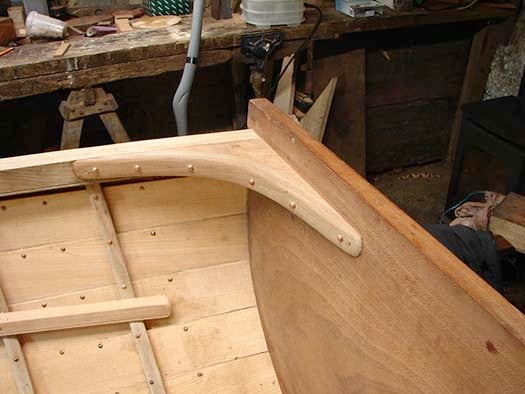
The detail is a joy to behold. One of the transom knees in a Jimmy Furey Water Wag. Photo: Cathy McAleavey
The joy of Jimmy Furey's work is in the detail, so it's no surprise to learn that he turns his hand from time to time to being an award-winning model maker. But the beauty of his boats, whether they be Shannon One Designs or Water Wags, is of such a high order that you could say they're of international classic model boat standard while happening to be full size boats which can give a good account of themselves on the race course.
There is only so much work that any one man, however talented, can do, so it's encouraging to know that Dougal MacMahon is following the Furey way, his most recent job being restoration work with new planks and gunwhale, and re-installation of the centreplate casing, in Ian & Judith Malcolm's hundred-year-old Dublin Bay Water Wag in order for the boat to be fit to take part in next month's massive migration of the Wags to the big Morbihan festival in south Brittany. There, they will link up for the first time with the new French-built Water Wag, the product of Skol ar Mor which has been bought by Adam Winkelmann of Dun Laoghaire.
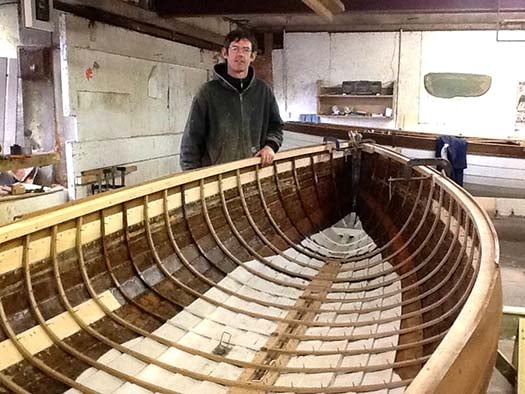
Dougal MacMahon of Belmont in County Offaly at the midway stage of this month's project to put a hundred-year-old Water Wag back into full health. Photo: Ian Malcolm
Having been looking at the new work on the Malcolms' Centenarian Barbara yesterday morning, rest assured that the Levinge/Furey style and quality is being upheld by Dougal MacMahon. Any good clinker-built racing boat will have a certain suppleness – indeed, it's said that one of the skinny Shannon One Designs will turn round and look at you when being driven to the utmost in a hard breeze. But with the Barbara, suppleness had deteriorated into sogginess. Yet less than two weeks of very concentrated work down in Belmont, with Dougal MacMahon as the master craftsman and Ian Malcolm as the gofer, has transformed the boat - there's new life in Barbara.
These days, Roy Dickson of Sutton is the doyen of boat building and modification through the use of modern materials. But as a recent celebratory lunch organized by his many shipmates past and present in Howth YC reminded us, in his astonishingly long career he did his duty and more by wood before bringing in various modern exotics. In fact, he started around 1950 with a Snipe called Bambi sailing out of the now defunct Kilbarrack SC on the north shore of Dublin Bay, whose demise began with its sailing waters inside the Bull Island being divided and made prone to silting by the construction of the fixed causeway across to the middle of the island.
Until that happened, KSC had a wonderful sheltered sailing area towards high water, as they'd a huge saltwater lake all the way to the Wooden Bridge. So they could get sailing even when conditions in Dublin Bay ruled out sailing at Sutton Dinghy Club itself. But soon enough, the young Roy Dickson had himself moved to Sutton, where he was Commodore in 1954, and he'd changed boats, building himself two Jack Holt-designed 16ft Yachting World Hornets – complete with International Canoe-style sliding seats for the crew - between 1954 and 1959, and racing them with success.
But as the best racing in Sutton was in the IDRA 14s, he built himself one of them in 1960, and then in 1961 he and Bunny Conn were in the forefront of the introduction of the Enterprise class, so that was his next command.
However, it wasn't until 1963 that all the Dickson stars came into alignment – the Fireball appeared. He was in there from the start – his first Fireball was No 38 – and with the class's flexible measurement system, the Dickson imperative for innovation had free range. And what he did was noticed by others. It's said that in his dozen or so years with the Fireballs, if some mod he made to his boat of the day proved beneficial, it would be done on every boat in Ireland within a week, and on every competitive boat in the world within a month.
As for Roy's sailing, he was competitive right up to world level, doing an early Fireball worlds in America with success with a youthful David Lovegrove, now President of the Irish Sailing Association, on the wire, with another Worlds in the Lebanon – God be with the days when you'd think of having a world sailing championship there – seeing one Bob Fisher as Roy's wireman.
Eventually, the Dickson campaigning moved into offshore racing with a succession of boats which, when combined with the possibilities provided by a variety of measurement rules, provided the artist with an enormous canvas to work with, and he was busy for decades. Most recently he has been best known for his stellar campaigns with the Corby 40 Cracklin Rosie and the Corby 36 Rosie, but we have to remember that by the time the boats left Roy's ownership, they were hugely different from the plans presented by John Corby.
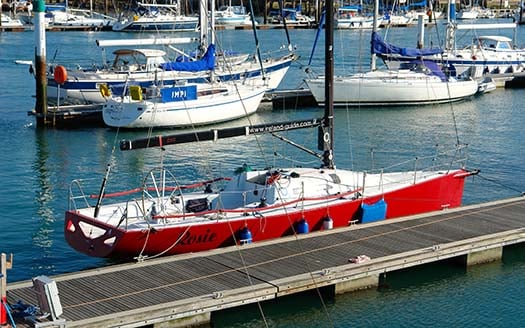
The Corby 36 Rosie was the last boat to be campaigned offshore by Roy Dickson in a remarkable career which has included several Fastnets and Round Ireland races in addition to success in Cork, on the Irish Sea, and in the Clyde. He now races the Corby 25 Rosie in club events. Photo: Brian Mathews
Each winter, the boats would be trailed back to a special spot beside Roy's house, and unless you were in constant attendance you'd no idea of just how much tweaking and surgery was taking place. He brings his brilliant engineer's brain to the challenges of boat performance enhancement, and many are the specialists who experienced that special thrill of anticipation when they got a Monday morning phone call from Roy which simply opened with the statement: "I've got an idea".
For as sure as God made little apples, an utterly fascinating project would follow, and even if it involved hours of brutal hard work by volunteers – such as the shifting of the weight configuration in the keel-bulb on Cracklin Rosie – well, Roy is the kind of leader who inspires people to loyal service way over and above the call of duty.
These days at age 83, Roy's sailing wings are slightly trimmed as he campaigns his Corby 25 Rosie in club events, but the mark he made in sailing inevitably makes you wonder if there's any modern equivalent to the innovations of Roy Dickson in his prime, and your only conclusion can be that the modern version would have to be a marine industry professional. And at the sharp end of Irish sailing development, there's no doubt that Chris Allen of Bray is the man to go to if you want thinking and work way outside the normal box.
Yet though he works with completely state-of-the-art composites, Chris is in the finest tradition of the invisible boat-builder. Bray may be a seaside town, but his workshop is well away from the harbour, in fact it's alongside a rather pleasant little residential development in the heart of Bray beside the River Dargle. But the workshop itself is a decidedly basic and utilitarian sort of place where the space is shared with a car restorer, and as the car-fixer works with a giant oven while Chris works with a small one in order to achieve the temperatures their composites require to cure, the fact that the shed was freezing – and that on a sunny April day – was neither here nor there.
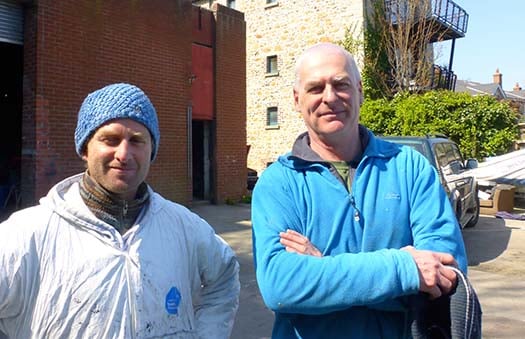
Graeme Grant and Chris Allen, the hidden boat-builders of Bray. Photo: W M Nixon
Chris's current project – on which he's working with Graeme Grant, Irish boat–building's favourite Scotsman – is building the very latest in the International Moths, complete with foils and a proven speed potential for normally competent dinghy sailors of thirty knots, while the sky's the limit speed-wise if you're a true ace.
{youtube}QlAzBoXy6g8{/youtube}
They've the tiny hulls and decks ready to go, but are being held up on completion by the late arrival of special components from various manufacturers. Meanwhile, they're busy with refining ever further the moulding of the struts which support the whole crazy caboodle of trampoline and rig and daggerplate and rudder and foil control, which means they're utterly absorbed in the sort of time-consuming task which would give any formal company financial controller the heeby jeebies.
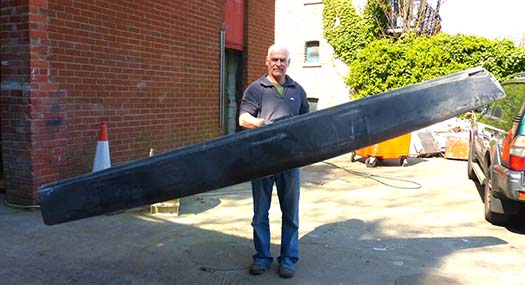
The carbon hull of a Chris Allen Moth is exceptionally light........Photo: W M Nixon
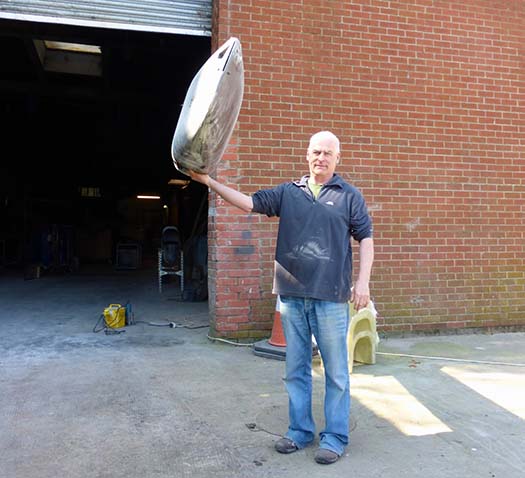
.....and we mean REALLY light. Photo: W M Nixon
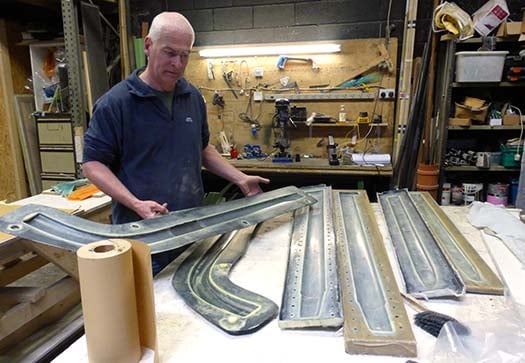
Chris Allen with moulds for the ultra-light struts for the International Moth. Photo: W M Nixon
But then Chris Allen's career path is scarcely along orthodox lines. He started his sailing on Lough Muckno in northeast Monaghan where his father – Dun Laoghaire sailor Hugh Allen, who had crewed with Alf Delany in the two-handed Swallow Class in the 1948 Olympics – had been posted as the Bank Manager in Castleblaney. Hugh Allen wasn't going to let the little dark hills of Monaghan end his sailing, so he built a Mirror and founded the White Island Sailing Club to race on the local lake, as he rightly reckoned that a Lough Muckno Yacht Club wouldn't quite do the business.
Subsequently he was posted to Moville in Donegal, and by this time he'd moved up to GP 14s, so we could argue that the current pre-eminence of Moville in Irish GP 14 racing goes right back to a former Olympic sailor being in the town. And it goes further than that, as the Allens' GP 14 was subsequently sold to a rising star in Dundalk sailing, one Pat Murphy......
Meanwhile, like many another young fellow, Chris Allen gave up sailing for ten years from the age of 18. He was into the music business, which isn't a sports-friendly way of life. But by the age of 28, sailing had hauled him back in again by way of Bray Sailing Club, and he was soon bring technical expertise to boats. Somehow or other, he ended up in New Zealand, and while his musical abilities were useful, his primary occupation was working with the innovative boatbuilder Cookson's, whose many successful creations have included Ireland's 2007 Fastnet Race winner Chieftain (Ger O'Rourke), a canting keel Farr 50.
For high tech boatbuilders, a spell working with Cookson's is the equivalent of a Harvard MBA for anyone who wants to rise in the corporate executive officer ladder. But back in Ireland, the corporate world is slightly more developed than the marine industry, and in hoping to use his skills honed in New Zealand, Chris Allen found he was building the hugely successful Velvet Glove for Colm Barrington in a shed in Enniskerry, and then when he came to build the arguably even more successful Ker 32 Voodoo Chile for Eamonn Crosbie, he'd found his current hidden premises in Bray.
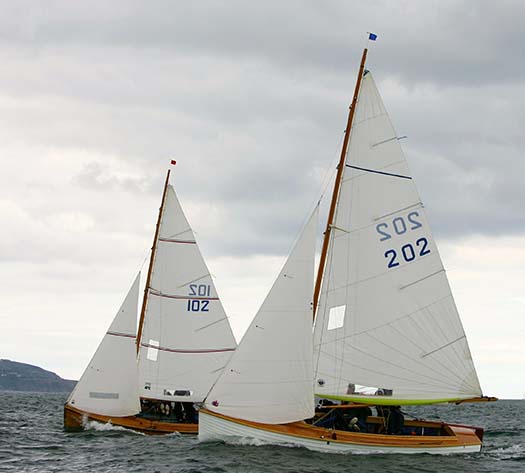
The glassfibre Mermaid Dolly (right) was a lovely piece of work by Chris Allen, but in the end the class decided to stay with timber construction.
His enthusiasm remains undimmed, as too does his readiness to express firmly-held opinions on boat-building of all kinds. But his skill in his specialist area is unrivalled, and he can be as versatile as any boatbuilder. Thus he was the man to go to in the days when the SB3 – then in its first incarnation as the SB20 – was experiencing a certain amount of teething problems. But equally, when Roger Bannon wanted to experiment with a GRP version of the Mermaid, he quite rightly reckoned that Chris Allen was the man to go to, and the result was one of the sweetest clinker GRP boats you'll ever see, even if the class in its wisdom decided eventually to stick doggedly with wood.
As we were in Bray, there'd been a hope of going on to see the two new Bray Droleens as they near completion, but in this case the invisible boat-building remained utterly invisible. The project is currently on hold while the workshop undergoes a renovation project, and the pair of little boats are temporarily in store in a shed whose key-keeper happened to be in the other end of County Wicklow. But nevertheless it's good to know that Anthony Finnegan and his team have continued the fine work started by the late Frank de Groot, and congratulations to Jim Horgan of Furbo on the south Galway coast, whose re-creation of a Droleen was recently awarded one of the Classic Boat Trophies in London.
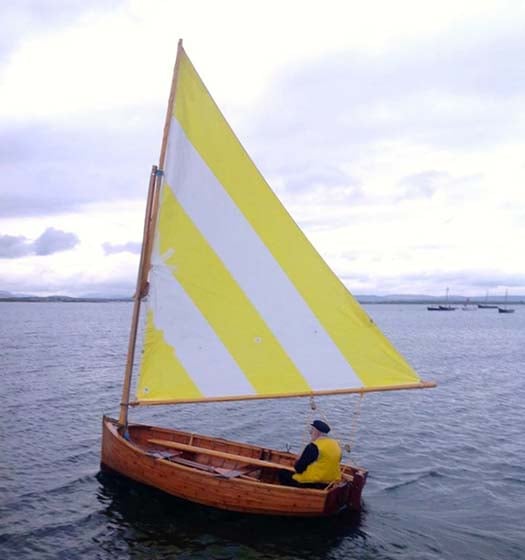
Jim Horgan sailing his award-winning Bray Droleen in Connemara
It was far from the world of classic boats that the next item on our North Wicklow agenda lay, as we were working on the ancient Chinese principle that seeing something once is worth hearing about it a hundred times, and we were determined to see for ourselves if the new multi-functional maritime clubhouse really is being built beside the re-developed harbour and marina in Greystones.
So, having been immersed for the morning in the hidden marine industry, that afternoon we had the modern marine industry in its most visible form. For although the new clubhouse is as yet barely above ground, it is definitely being built. And nearby at the marina, James Kirwan and the team in BJ Marine were in hospitable form on a perfect sunny day with a steady stream of seriously interested visitors coming to see fully finished yachts in showroom condition. It was like a different planet, and we much enjoyed a conducted tour of a spanking new Oceanis 38 which has been prepared and laid out for a Dun Laoghaire owner who is quite clear in his own mind that he only intends to use the boat for day-sailing and hospitality purposes.
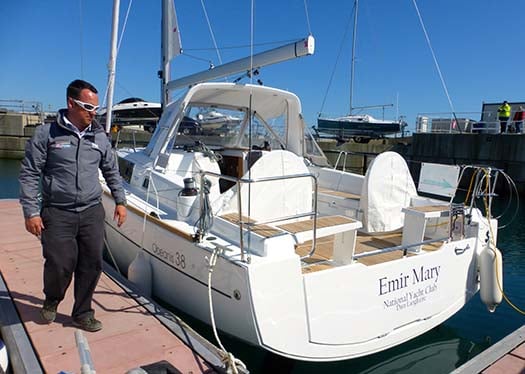
The way we live now.....James Kirwan of BJ Marine with a new ready-to-go Oceanis 38 in Greystones Marina. Photo: W M Nixon
Believe me, with the sun shining down and James Kirwan enthusing about the success of the new BJ Marine linkup to the Snowdonia Riviera on Tremadoc Bay with their latest office in Pwllheli in North Wales, you could be very easily seduced into availing of all the ready accessibility of today's front-line marine industry if you just happen to have the magic ingredient of enough money. But for most of us still spluttering our way out of the deluge which was the recession, it's a matter of making do as best we can.
And for others, the shiny new boats are not the way to go at all. On the contrary, they want to experience traditional hands-on lovingly crafted boat-building for personal fulfillment as much as having a boat at the end of it, and out the back of Clontarf Yacht & Boat Club there's a kind of Men's Shed operation convened by Ronan Melling which has been building a classic IDRA 14 for quite some time now, but the results show that they're willing to learn, and nothing is too much trouble to achieve perfection.
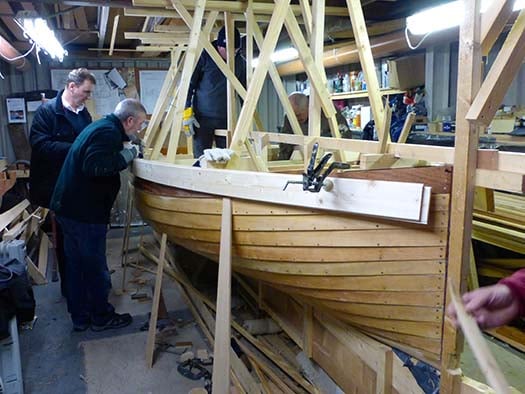
And now the tricky bit.....a spot of concentrated thinking under way last November as the Clontarf team grapple with the challenge of steaming and installing the frames in their new IDRA 14. Photo: W M Nixon
It's also the very essence of the invisible boat-building spirit, as they're only in action on specific nights for work spells of set duration. But on a first visit last November when you could already see that the planking work was of the highest quality, they'd got to the crucial stage of putting in the first steamed frame, which with all the hassle of keeping a steamer up to heat, is quite a step for an amateur team.
But they persevered despite having problems with several types of steam boxes, and then somebody had the wonderful idea for the Clontarf Contrivance. Somehow they made the leap from thinking how steaming a frame is a matter of keeping up pressure to the notion that a bicycle tyre is also a matter of keeping up pressure. The inner tube from a bicycle tyre, with a bit of another inner tube added for the required length, will neatly accommodate the complete frame for an IDRA 14. All you need to do is put the steam into it under the optimum amount of pressure. It has worked, for as the most recent photos show, the task so tentatively begun last November is now complete with as neat a framing jib as you could hope for.
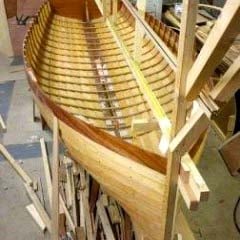
As neat a job as you could wish. The new IDRA 14 with the frames in place.
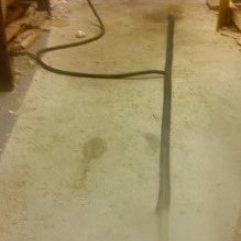
The secret weapon. We all know what a bicyle inner tube looks like, but have you ever thought of it as the Clontarf Contrivance for steaming frames for clinker-built boats?
The spirit of doing it for yourself is if anything even stronger along Ireland's western seaboard, and back in SailSat for the 29th March 2014 we featured – among many other boats – the Atkins schooner which the great Jarlath Cunnane was building for himself in Mayo in anticipation of the eventual sale of his Arctic Circle-girdling Northabout.
Well, Northabout has now been sold and will be going to the Antarctic as an expedition boat, but meanwhile last Autumn I grabbed a quick photo of the new schooner finally out of the building shed (which for once actually is a waterside shed), and we look forward to seeing her afloat and in action.
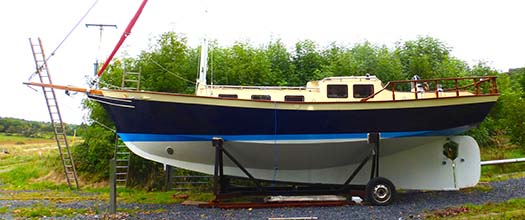
Shaping up nicely. Jarlath Cunnnane's new alloy-built schooner. Photo: W M Nixon
Far to the south along the Atlantic seaboard, and up the winding Ilen River above Baltimore you'll find Oldcourt and the Old Corn Store where the restoration of the Conor O'Brien ketch Ilen is moving steadily along. But as the Ilen project is ultimately Limerick based, the fine premises in Limerick where Gary MacMahon and his team built both the traditional gandelows and the CityOne dinghies provides an excellent workshop for building the more detailed parts of Ilen, and this week Gary circulated a photo of the deckhouse which will go above the engine room, and very well it looks too.
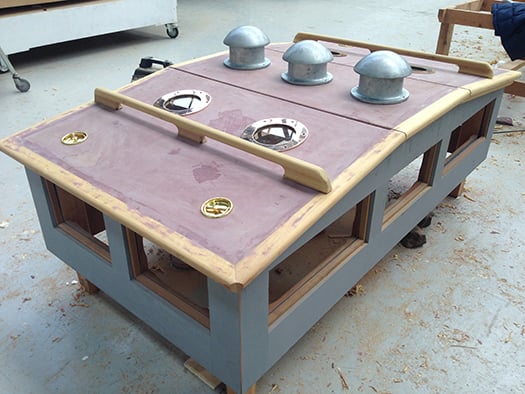
Ilen's new engine room deckhouse, workshop-built in Limerick. Photo: Gary MacMahon
For in winter, there is nothing more conducive to getting jobs completed than having adequate resources and a clean and comfortable workshop where you've a bit of space to go about the project, which so often is not the case for Ireland's hidden boat-builders.
But they do things differently in other places. Back in SailSat of February 7th this year, we ran a piece which included news about a restoration project which is under way with a specialist company in Palma in Mallorca, giving new life to the 37ft Fife-designed Belfast Lough One Design Tern of 1897 vintage. We published a photo of Tern as she was in July 2014, striped off and ready for the work. On Thursday, I received two photos of Tern being launched on Wednesday after nine months work. Just to show what has been achieved, we start with that photo of Tern in July 2014. Further comment is superfluous.
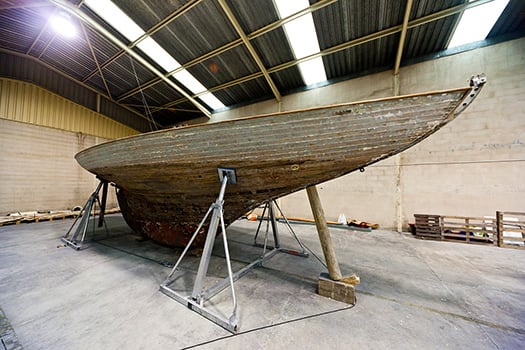
Tern as she was in July 2014.
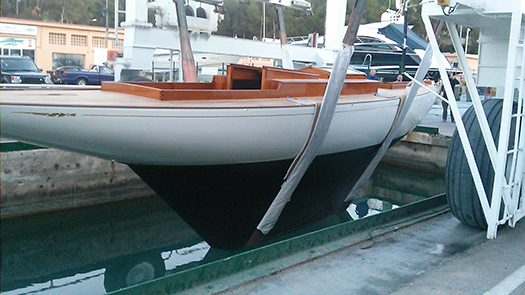
Tern as she was last Wednesday, test launching in Palma.
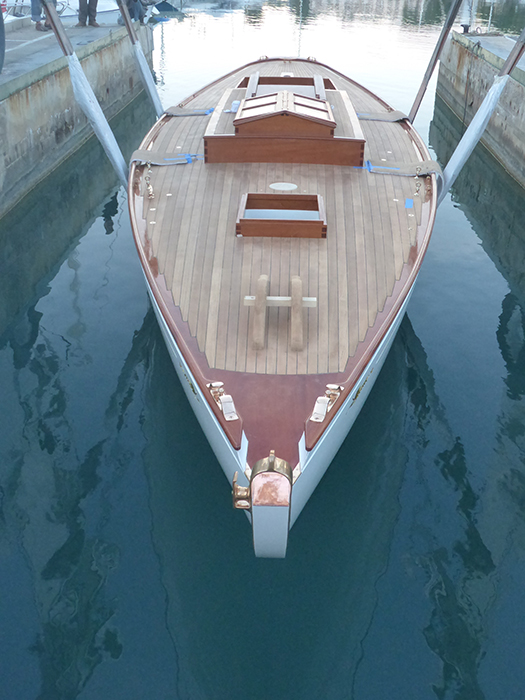
Work of the ultimate quality. Tern's new bronze deck fittings are probably worth more than the boat herself was when she was built to a fairly basic specification by John Hilditch of Carrickfergus in 1897.































